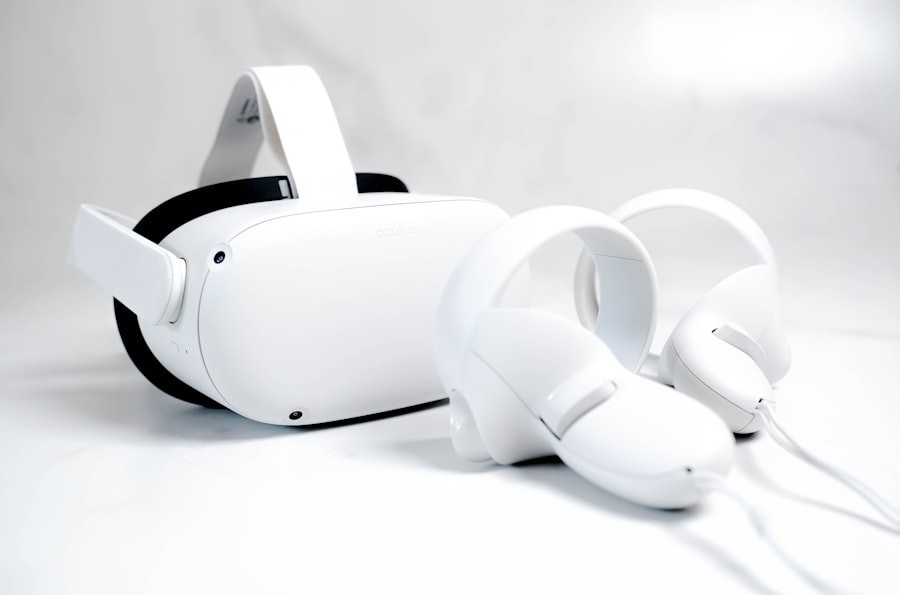The Meta Quest 2, formerly known as Oculus Quest 2, represents a significant leap in the evolution of virtual reality (VR) technology. This standalone headset allows users to immerse themselves in a digital universe that transcends the limitations of physical reality. The term “metaverse” refers to a collective virtual shared space, created by the convergence of virtually enhanced physical reality and physically persistent virtual reality.
In the context of Meta Quest 2, this means users can engage in a variety of experiences, from gaming to socializing, all within a seamless digital environment. At its core, the Meta Quest 2 metaverse is built on the principles of interactivity and immersion. Users can explore vast landscapes, interact with other avatars, and participate in activities that range from casual gaming to complex simulations.
The device’s advanced features, such as hand tracking and high-resolution displays, enhance the sense of presence, making users feel as though they are genuinely part of the virtual world. This immersive experience is further enriched by the ability to connect with friends and strangers alike, fostering a sense of community that is often lacking in traditional gaming environments.
Key Takeaways
- The Meta Quest 2 Metaverse is a virtual reality platform that allows users to interact and engage in a digital world.
- Navigating the virtual world of Meta Quest 2 involves using VR technology to explore different environments and engage with other users.
- Building your virtual identity in the Meta Quest 2 Metaverse involves creating an avatar and customizing it to represent yourself in the digital world.
- Exploring social interactions in the Meta Quest 2 Metaverse includes engaging with other users through chat, voice, and virtual activities.
- Creating and customizing your virtual space in Meta Quest 2 allows users to personalize their digital environment and make it their own.
Customizing Your Virtual Home
Upon donning the headset, users are greeted with a home environment that serves as a launching pad for their adventures. This virtual home can be customized to reflect personal tastes, providing a sense of ownership and identity within the metaverse.
Users can easily access various applications and games through a straightforward menu system, allowing for quick transitions between experiences. The navigation within individual applications is equally engaging. Many VR experiences utilize natural gestures and movements, enabling users to interact with their surroundings in a way that feels organic.
Immersive Gaming Experiences
For instance, in gaming scenarios, players can physically move around their play area, ducking behind virtual cover or reaching out to grab objects. This level of physical engagement not only enhances gameplay but also encourages users to be more active, blurring the lines between physical and virtual activity. As users become more familiar with their virtual surroundings, they often discover hidden features and shortcuts that enhance their overall experience.
Building Your Virtual Identity in the Meta Quest 2 Metaverse

Creating a virtual identity in the Meta Quest 2 metaverse is an essential aspect of the user experience. The platform allows for extensive customization of avatars, enabling users to express their individuality through various physical traits, clothing options, and accessories. This personalization fosters a deeper connection to one’s virtual self, as users can choose features that resonate with their real-world identity or explore entirely new personas.
Moreover, the significance of avatar representation extends beyond mere aesthetics. In many social interactions within the metaverse, avatars serve as a reflection of personality and social status. Users may opt for unique outfits or rare items that signify achievements or experiences within the virtual world.
This aspect of identity construction can lead to a rich tapestry of social dynamics, where users engage in conversations about their avatars’ backstories or the journeys they undertook to acquire specific items. The ability to curate one’s virtual identity not only enhances personal expression but also plays a crucial role in how individuals interact with others in this expansive digital landscape.
Exploring Social Interactions in the Meta Quest 2 Metaverse
| Metrics | Value |
|---|---|
| Number of users | 500,000 |
| Average session duration | 45 minutes |
| Number of social interactions | 2,000,000 |
| Most popular virtual locations | Virtual cafes, concert venues |
Social interactions within the Meta Quest 2 metaverse are multifaceted and dynamic, offering users a plethora of ways to connect with others. The platform supports both synchronous and asynchronous interactions, allowing users to engage in real-time conversations or leave messages for friends to discover later. This flexibility caters to various social preferences and schedules, making it easier for individuals to maintain connections regardless of geographical barriers.
In addition to direct messaging and voice chat features, users can participate in group activities such as multiplayer games or collaborative projects. These shared experiences foster camaraderie and teamwork, as players must communicate effectively to achieve common goals. For example, in cooperative games like “Rec Room,” players must strategize together to complete challenges, enhancing their social bonds through shared victories and defeats.
Furthermore, the presence of virtual events—such as concerts or meetups—provides additional opportunities for socialization, allowing users to gather in large groups and experience entertainment together in real-time.
Creating and Customizing Your Virtual Space in Meta Quest 2
One of the standout features of the Meta Quest 2 metaverse is the ability for users to create and customize their virtual spaces. These environments serve as personal havens where individuals can express their creativity and design preferences. Users can choose from various templates or start from scratch to build spaces that reflect their unique tastes and interests.
This level of personalization not only enhances the aesthetic appeal of one’s virtual space but also allows for functional adaptations based on individual needs. For instance, a user might create a cozy lounge area for social gatherings or a dedicated workspace for productivity within the metaverse.
The ability to curate these environments fosters a sense of belonging and ownership, making each user’s experience distinctively their own.
Engaging in Virtual Economy and Commerce in the Meta Quest 2 Metaverse

Virtual Commerce and Entrepreneurship
Within the metaverse, users can engage in various commercial activities, such as designing and selling unique items or experiences through integrated platforms. This encourages innovation and experimentation with different designs and concepts to attract buyers, fostering an entrepreneurial spirit among users.
Monetizing Skills and Services
Some platforms within the Meta Quest ecosystem enable users to monetize their skills by offering services like virtual event planning or guided tours through popular VR destinations. This adds a new dimension to the metaverse experience, allowing users to capitalize on their expertise and interests.
The Economic Aspect of the Metaverse
The potential for financial gain in the metaverse is a significant motivator, encouraging users to explore and engage with its economic aspects more deeply. As users participate in the virtual economy, they can develop a more profound understanding of the metaverse and its many possibilities, from creating and selling digital goods to providing services and experiences.
Participating in Virtual Events and Entertainment in Meta Quest 2
The Meta Quest 2 metaverse is rich with entertainment options that cater to diverse interests. Users can attend virtual events ranging from live concerts featuring popular artists to immersive theater performances that transport audiences into fantastical narratives. These events often leverage cutting-edge technology to create engaging experiences that would be impossible in traditional settings.
For example, platforms like Horizon Worlds host regular events where users can gather for trivia nights or art showcases. These gatherings not only provide entertainment but also foster community engagement as participants interact with one another in real-time. Additionally, gaming tournaments attract competitive players who showcase their skills while vying for prizes or recognition within the community.
The variety of entertainment options ensures that there is something for everyone in the Meta Quest 2 metaverse, making it a vibrant hub for social interaction and cultural exchange.
Embracing the Future of the Meta Quest 2 Metaverse
As technology continues to advance at an unprecedented pace, the future of the Meta Quest 2 metaverse holds immense potential for growth and innovation. With ongoing developments in VR hardware and software, users can expect increasingly sophisticated experiences that blur the lines between reality and virtuality even further. Enhanced graphics, improved haptic feedback systems, and more intuitive controls will likely redefine how individuals interact with digital environments.
Moreover, as more creators enter the metaverse space, there will be an influx of unique content that enriches user experiences. From educational programs that leverage VR for immersive learning to artistic endeavors that push creative boundaries, the possibilities are virtually limitless. As communities continue to form around shared interests and experiences within this digital realm, the Meta Quest 2 metaverse will evolve into an even more interconnected ecosystem where collaboration and creativity thrive.
In summary, understanding and engaging with the Meta Quest 2 metaverse opens up a world of possibilities for users seeking immersive experiences that blend entertainment, social interaction, and personal expression. As this digital landscape continues to expand and evolve, it promises to reshape how we connect with one another and experience reality itself.
If you’re interested in learning more about metaverse platforms and ecosystems, you should check out this article on social virtual worlds. It delves into the various platforms and ecosystems that make up the metaverse and how they are shaping the future of virtual reality. Additionally, if you want to explore the intersection of virtual reality and the physical world, you might find this article on augmented reality fascinating. And for further reading on the topic of the metaverse, be sure to check out the recommended books and publications in this list of resources.
FAQs
What is Meta Quest 2 Metaverse?
Meta Quest 2 Metaverse refers to the virtual reality platform created by Meta (formerly known as Facebook) that allows users to access a variety of virtual experiences, social interactions, and entertainment content.
What can users do in Meta Quest 2 Metaverse?
Users can engage in a wide range of activities within the Meta Quest 2 Metaverse, including playing games, attending virtual events, socializing with others, exploring virtual environments, and accessing immersive content.
How does Meta Quest 2 Metaverse work?
Meta Quest 2 Metaverse operates through the use of virtual reality headsets, such as the Meta Quest 2, which allow users to enter and interact with the virtual environment. Users can navigate the Metaverse using hand controllers and experience a sense of presence in the virtual world.
What are some popular features of Meta Quest 2 Metaverse?
Popular features of Meta Quest 2 Metaverse include virtual reality gaming, live events and concerts, virtual meetings and gatherings, immersive storytelling experiences, and the ability to create and customize virtual avatars.
Is Meta Quest 2 Metaverse accessible to everyone?
Meta Quest 2 Metaverse is designed to be accessible to a wide range of users, including those with Meta Quest 2 headsets and compatible devices. However, access to certain features and experiences within the Metaverse may require additional subscriptions or purchases.

Leave a Reply